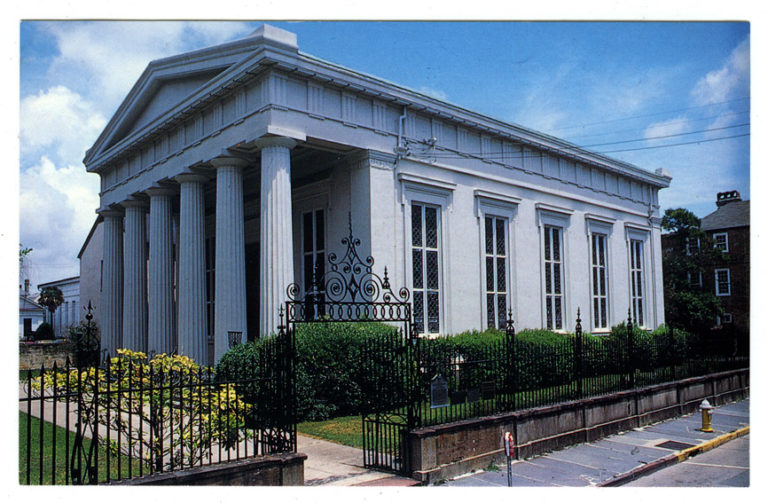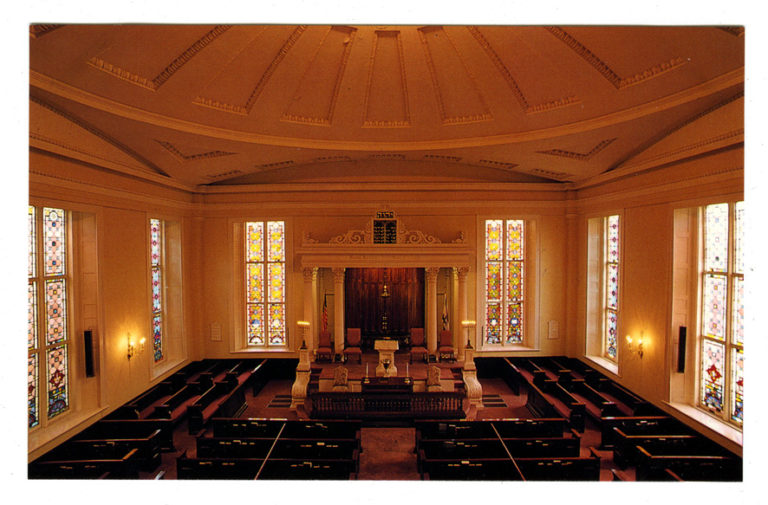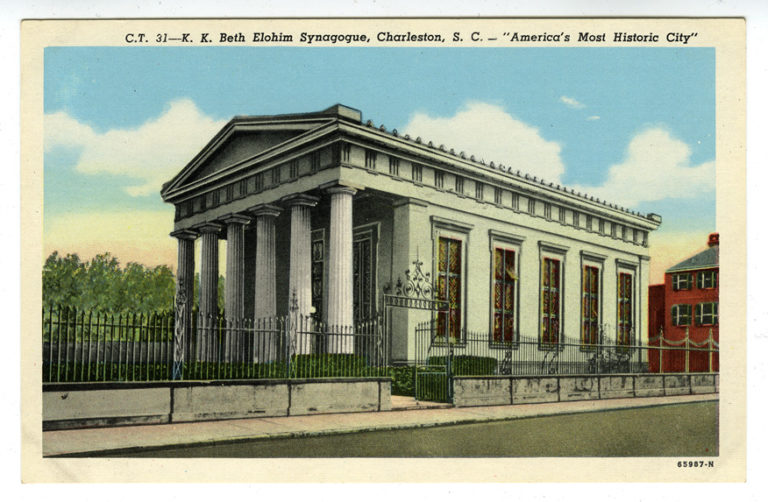1.1 Charleston, South Carolina
Kahal Kadosh Beth Elohim, 90 Hasell Street
Cyrus Warner, architect (based on designs by Tappen & Noble); David Lopez, builder, 1841
The Valentine & Sons’ Publishing Co., Ltd., New York, publisher; no date
The postcard depicts Kahal Kadosh Beth Elohim (Holy Congregation House of God) in Charleston, South Carolina, the second oldest extant purpose-built Jewish religious building in the United States, after Touro Synagogue in Newport, Rhode Island. It is the oldest in the South. It is also venerated as the birthplace of Reform Judaism in America.
The Greek Revival building is striking. After the Charleston fire of 1838 destroyed the Federal-style sanctuary KKBE had dedicated in 1794, the congregation built a new synagogue in the then-favored mode of classicism, linking their enterprise with the broader civic architectural mission of the young republic, and associating this Jewish house of worship with the many Christian churches and public buildings erected in Charleston in the years following the Great Fire.
The congregation solicited several proposals and favored the Greek-inspired design of builders Tappan and Noble, which was sent to New York architect Cyrus Warner for refinement and finished drawings. Warner is listed as the architect of record. When the new building was consecrated in March 1843, “the crowd assembled was so great that hundreds were compelled to retire, being unable to obtain an entrance.” 1
The Jewish publication the Occident, edited by Isaac Leeser and published in Philadelphia, described the building as “of the most chaste and classical architecture.” Depicting the Greek features in exacting detail, the author declared, “It is the model of a Prostyle Grecian Doric Temple.” Just when we wonder if this is a Jewish building at all, we learn that “over the door . . . is a marble tablet, bearing the following inscription in Hebrew and English: “שמע ישראל יי אלהינו יי אחד / ‘Hear, O Israel, the Lord our God is the sole Eternal Being.’”2
Inside, on the east wall the ark is of polished mahogany, “of a semi-elliptical form, the base enriched with acanthus leaves. When opened it presents the interior richly decorated with crimson satin damask drapery. The receptacle for the ark, or covering beneath which it stands, is supported by ten columns and antaes [sic] of the Corinthian order.” A black marble frieze is inscribed in large gilt letters: “Know before whom thou standest.” Two black marble tablets of the Decalogue with gilt letters surmount the ark. Originally, “near the west entrance [was] the Taybah [sic], a square elevation, surmounted by a rich and highly polished mahogany balustrade in keeping with the gallery. . . . On this platform is the desk of the Hazan, supported by a rich mahogany table; a highly wrought mahogany sofa stands on the west end of the platform, and on its four corners are placed four large candlesticks of the same style and description of those near the ark.”3
The synagogue builder was David Lopez, a proficient contractor and, at the time, a member of the Charleston congregation. The Occident remarked: “The order, finish, and decorations of the entire building have been justly admired, and reflect the highest credit upon our townsman, Mr. David Lopez, a native mechanic, and one of our persuasion.” Barry Stiefel has pointed out in his study of Lopez’s life and career that KKBE is “the first synagogue built by a practicing Jew in the Americas,” and one that was built with enslaved labor.4 The Occident reported that the board of trustees of the congregation passed a resolution praising Lopez’s work.5
When erected in 1841, Beth Elohim introduced Reform elements, including a pipe organ in the balcony and certain liturgical changes. As would soon happen in other cities, the traditionalists seceded and formed a rival congregation, Shearit Israel, with its own burying ground adjacent to Beth Elohim’s Coming Street Cemetery.
After 1850 Reform Judaism expanded dramatically across the nation, but enthusiasm for the Greek Revival style waned and went entirely out of fashion following the Civil War. Nonetheless, in 2021, Charleston’s earliest congregation continues to worship in the historic building, which is lovingly maintained.
1 Charleston Mercury, March 20, 1841, quoted in Solomon Breibart, “The Synagogues of Kahal Kadosh Beth Elohim,” South Carolina Historical Magazine 80, no. 3 (July 1979): 224.
2 N[athaniel] L[evin], “The Jewish Congregation of Charleston,” in the Occident and American Jewish Advocate 1, no. 10 (January 1844): 492.
3 Ibid., 494.
4 Barry Stiefel, “David Lopez Jr.: Builder, Industrialist, and Defender of the Confederacy,” American Jewish Archives Journal 64, nos. 1 and 2 (2012): 53, 57.
5 “Resolved, That the board of Trustees fully appreciate the admirable manner in which the contract to build the new Synagogue has been carried out by the builder, Mr. David Lopez, not only with respect to the materials used, but also the superior workmanship, zeal, taste and fidelity exhibited throughout.” Quoted in the Occident and American Jewish Advocate 1, no. 10 (January 1844).




